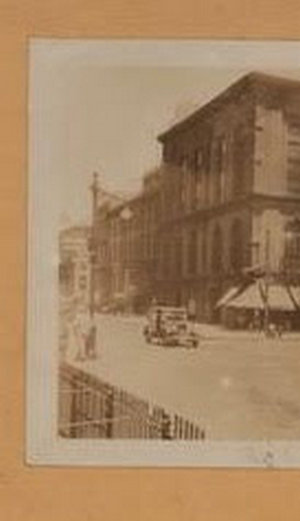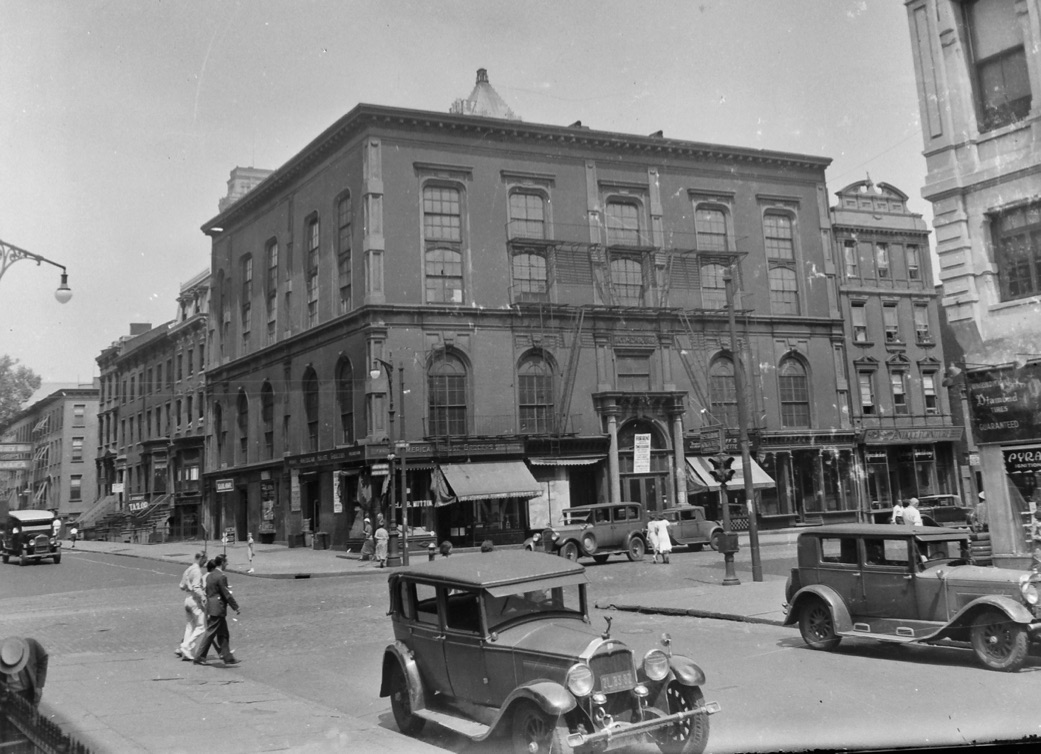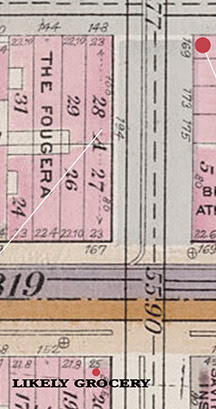This week in my ‘Picture Postals’ series of posts, more follow-on from my recent successful search for Lovecraft’s “John’s” in Brooklyn.
1) Here are two Photoshop-combined sections of Sanborn’s 1904 Brooklyn Atlas, showing 7 Willoughby Street (John’s) in plan and context.
We can see here that No. 7 (“John’s”) had a large isolated yard and sheds out back. This is possibly of relevance re: it being a suitable-looking site for prohibition hooch-brewing in the back yard, something which we know went on regularly at the main branch of John’s. Note the adjacent cigar making, carpet cleaning and gas-fitting. Alcohol fumes from the stills might have been well cloaked by the neighbouring pongs. Possibly there was also a back-entrance to the yard, for small trucks using the insalubrious Union Lane. Looks to me like a perfect site for prohibition brewers in 1925.
2) In my recent search for Lovecraft’s Clinton St. grocery, I can now discount the store on the ‘bank’ corner of Atlantic Avenue – Clinton Street. You’ll recall there was a savings bank on one of the four possible corners, a bank that had departed the area in 1922. A 1927 picture shows that a corner store there, visible on that corner in the early 1940s, was not yet in existence at 1927. This discovery further confirms that Lovecraft’s grocery store was at 156 Atlantic Avenue, on the corner with Clinton.
In the same set of pictures there is a 1935 picture of 156 Atlantic Avenue. This is in one of the same set of Sperr pictures, Brooklyn: Clinton Street – State Street. But this picture has been confusingly titled. Its title implies that it shows State Street but it does not, as the label on the back indicates. It is merely “south from State Street”, i.e. made at a point south ‘on the map’, but with State St. behind the cameraman. To someone who knows what they’re looking at, this April 1935 picture shows Lovecraft’s Clinton – Atlantic Avenue corner, as seen from the waste-ground of the demolished Fougera apartments. Thus Lovecraft’s grocery is partly visible behind parked cars, on the very far right of the picture…
Regrettably this is one of the Sperr pictures that the NYPL hold hostage for their expensive “fine art prints” racket.
3) Also in the Sperr pictures, I found a better angle in a picture that looks down Clinton Street. Brooklyn: Clinton Street – Atlantic Avenue, early June 1927. A date which was little more than a year after Lovecraft had returned to Providence. The druggist (chemist) is on the corner with its awnings up against the sun, and Lovecraft’s Clinton St. is falling away at the left of the picture, as seen below. Lovecraft’s room at No. 169 is on the far corner, slightly obscured by a nearer lamp-post. Sperr’s label on the back has a description and the “June 1927” date. I think this may be the first time this particular picture has been identified with No. 169, and it’s very close in time.
Sadly it’s another of the Sperr pictures that the NYPL hold hostage for their “fine art prints”. Online it is very low-res, but apparently the NYPL do have larger as a very expensive “art print” — and seemingly with no actual guarantee that the image quality will be any better. You might end up with a $150 blur.
However, discovering that the corner building had once been the “Brooklyn Atheneum” aka “Athenaeum” opened doors to new data, and I found more or less the same view on a Brooklyn Eagle postcard…
Late 1890s. The Brooklyn Historical Society hold the plate.
We can see “Heyder[eich?]” the druggist was there on the corner in the late 1890s, as he was in the 1935 and 1940 pictures of the same corner. He appears to have been there all the way through, circa 1890s-1940.
What of the Atheneum? The Atheneum had once been a large concert hall, assembly rooms and then a private mercantile subscription library, and there was indeed a druggist on the corner (a chemist shop, as I had suspected). Its heyday as a modern venue was the 1850s-70s, and later as a theatre and lantern-projectionist forum in the 1880s. Nothing is heard of it after that as a regular cultural venue. But there was an attempted mass-meeting of East Coast anarchists there in 1901, as a result of which… “police closed down the Athenaeum”. The building was then swiftly leased by the New York Court of Special Sessions (of the Second Division, meaning Brooklyn, Queens and Richmond). “The Second Division the Court of Special Sessions is now held at the corner of Atlantic avenue and Clinton street” at “171 Atlantic Avenue”. Rather too swiftly occupied, since the officers complained for several years about the badly leaking roof, until the place was eventually refurbished. The Court’s lease was renewed in 1922, the year when the building was sold to a new owner by what a real-estate trade-paper called the “old” Athenaeum. The new owner appears to have been making a long-term investment on the corner site rather than the creaky old building — it was listed for demolition as part of “slum clearance” and abruptly demolished in 1942.
When Lovecraft was living at No. 169 this corner of Clinton and Atlantic was thus a court for the trying of petty crimes. Crime that merited either a fine, or some days in jail or a youth reformatory. It may not have sat as a court every day, but its presence would often have ‘flavoured’ the surrounding sidewalks with a seedy and anxious atmosphere.
The Athenaeum’s final days are seen here, photographed circa 1941-42 by Irving Kaufman, with the demolition placard on the front…
Old Brooklyn Athenaeum / Second Division of the Court of Special Sessions, before demolition. Also Clinton Street and No. 169. Photo by Irving Kaufman (1910–1982). Kaufman’s son Phil Kaufman was until a few years ago able to provide prints. But Phil Kaufman’s website has now gone, and at the time he posted these prints he did not know where they had been photographed. Just that they showed large Brooklyn buildings that were declared for demolition.
Here the old corner druggist has gone at last and the store has become an opportunistic grocer, “American **st Grocers(?)”, for a year or so before demolition. But this is long after Lovecraft’s time there. Still, it gives us another new picture looking down toward No. 169 Clinton St. and we get a feel for Lovecraft’s walk up to his Syrian tailor’s and to the corner, before crossing Atlantic to reach his usual grocery store.
In a further Irving Kaufman picture we can also see the immense ‘Fouguera’ apartments building that loomed opposite Lovecraft in Clinton St. This picture shows the other side of the street, and a distinctive corner of the druggist’s frontage can be seen in the bottom-right (it has a ‘pig snout’ moulding that can’t be mistaken). Comparing the styling of this frontage, just visible enough, with the 1935 and circa 1940 pictures to show that it it not yet the grocer’s seen in the circa 1941 picture. In that latter picture the grocer has re-tooled the signage boards somewhat. This ‘Fouguera’ photo must be earlier than circa 1941. Indeed, it must be circa 1934-35 because 1934 was when the ‘slum clearance’ demolition boards went up on the building, as noted by the Brooklyn Eagle. These boards can be clearly seen on the building.
We can also more clearly see the nature of the corner shop at the ‘Fouguera’. It was a furniture store with what seems to be an antique bric-a-brac wing with a show-window on the corner.
To summarise, my search for Lovecraft’s grocery has found the store, and has also established several other useful facts along the way. Lovecraft would have walked toward the grocers on Clinton/Atlantic through a ‘canyon’ like street, with the immense ‘Fouguera’ on one side, and the old Brooklyn Athenaeum on the other. If he walked from his room into this canyon during the day he might have encountered many people going to or from the Second Division the Court of Special Sessions, Brooklyn’s court for petty crime that was held in that building. Such anxious or hard faces cannot have raised his general assessment of the immediate area. Culture and thrift was fading away. The old Athenaeum had gone, the Saving Bank on its opposite corner across Atlantic had departed in 1922 (and seemingly also the artists who had some sort of informal studio colony above it). The once proud ‘Fouguera’ was (in the eyes of the city) now becoming the slum that would condemn it in 1934 and with a seedy-looking furniture store and a seedy cafe below. The old druggist on the Athenaeum corner, “Heyder[eich?]”, kept up the tone. The grocery at No. 156 Atlantic Avenue was worth patronising and affordable, and presumably friendly. But the area was obviously going downhill despite a superficial aura of fading quality, as Lovecraft’s letters also evidence.
Map showing Lovecraft’s room at 169 and the four corners of Clinton/Atlantic. Clockwise: ‘Fouguera’ and bric-a-brac shop; Athenaeum (now the petty-crimes court for Brooklyn) and Druggist; the old Savings Bank (lower part not a store until after 1927); and then the grocery at 156 Atlantic.








